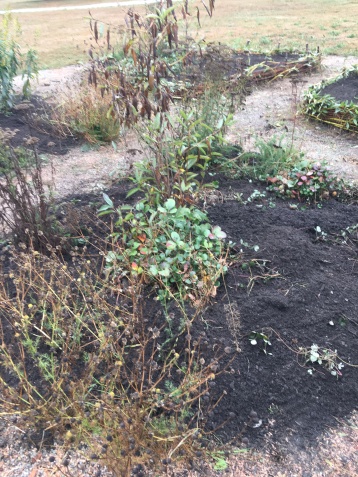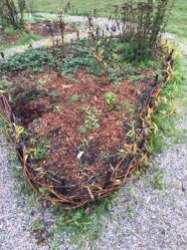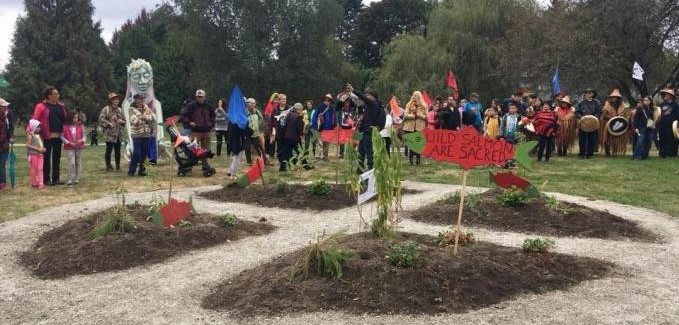
This medicine wheel garden was created on September 24, 2017 as part of the Wild Salmon Caravan, a celebration of wild salmon and indigenous food sovereignty. It was built by the Cedar Cottage Food Network in partnership with Vancouver Park Board and Trout Lake Community Centre.
A medicine wheel is an indigenous teaching that shows the inter-connectivity of different parts of life in relation with the nature and the spiritual world. The design consists of four different parts that represent directions, elements, seasons, or nations among many others. Traditionally, the medicine wheel is used for ceremonious, religious, and healing purposes, or to illustrate cultural concepts.
The garden is now a learning garden where we grow native and medicinal plants for the community and held workshops.
Plant List
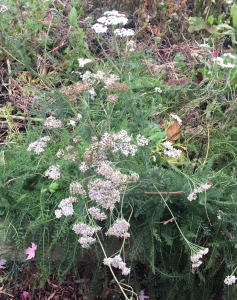
Achillea Millefolium Yarrow Astringent, anti-microbial, anti-inflammatory, pain reliever. Poultice or powder of leaves stops bleeding and prevents infection. Flowers can be taken internally for fevers and colds, as a digestive aid and tonic, to ease menstrual cramps and heavy bleeding or to bring on menstruation. Leaves are edible, young leaves are less bitter. Found in dry meadows or shady and moist edges and is found in disturbed areas. Does not tolerate shade well, but grows well on poor soils. Drought tolerant.
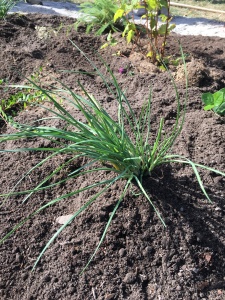
Allium Cernuum Nodding Onion Perennial native to open woodlands throughout hardiness zones 3-9. The flowers are very attractive to bees and hummingbirds for their nectar and are often planted in native habitat restorations. Nodding Onion has similar culinary and medicinal uses to other species in the Allium genus such as garlic, onions, and chives. The Straits Salish, Cowichan, Sechelt, Squamish, Comox and Halq’emeylem of the Fraser Valley ate the bulbs, either raw or steamed in pits.
Camassia Quamash CST PNW Common Camas Coastal An important staple food for First Nations people of the Pacific Northwest, especially the coast. The bulbs were pressed into small bricks and steamed in pits, usually for 24 hours. The cooked bulbs were sweet and could be eaten immediately or sun-dried and stored or used in trade. The bulbs were not consumed raw. Grows on grassy slopes and meadows at low to mid elevations; only in rainshadow climates. NOTE: Common Camas is easily confused with Death Camas, as they often grow nearby. Death camas has white flowers, whereas common camas has blue flowers.
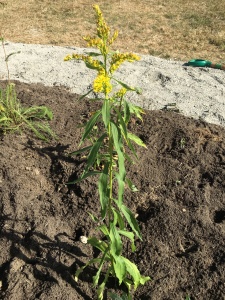
Solidago Canadensis Goldenrod Goldenrod is a remedy for inflammation of the respiratory tract, especially when there is a build up of mucus. It calms inflammation of the throat, trachea, bronchi, and bronchioles, and helps the body to expel excess mucus contained in these passages. Also used for treatment of bladder infections, due to its diuretic, antiseptic, and anti-inflammatory properties. It makes a good tonic herb for strengthening the bladder and kidneys. Leaves make a yummy tea. It enjoys a moist spot in sun or part-shade and can be found in gardens, along roadside, moist meadows, and along the edges of clearcuts.

Lupinus Polyphyllus Big Leaf Lupine Bigleaf lupine attracts native bees, bumble bees, and other beneficial insects with its nectar and pollen-rich flowers that bloom from mid-spring into mid-summer. Although the Thompson band of British Columbia considered it poisonous, they used it medicinally for themselves and their horses. The Salishan used it to make tonics and the Kwakiutl ate the roots, fresh or steamed. This species prefers moist habitats and seasonally wet soils, but will tolerate seasonal dryness.

Arctostaphylos Uva-ursi Coastal Kinnikinnick Kinnikinnick can be consumed either raw or cooked. Although the berries are too dry to eat alone, several northwest First Nations communities mixed them with fat or boiled them in soups. In terms of medicinal use, the leaves were infused and drink it as tonic. This infusion could also be used as mouthwash for canker sores or weak gums. It was also made into a decoction and drunk for colds, tuberculosis, and sore eyes. Amongst the Haida, the leaves were used as a diuretic in kidney diseases and infections of the urinary passages. This plant is rich in tannin and arbutin and should be used with caution. Likes part shade or sun, tolerates a variety of soils but prefers sandy loam, drought tolerant.
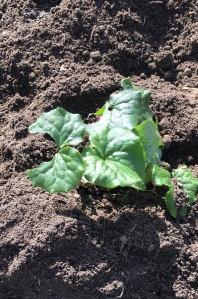
Asarum Caudatum Wild Ginger Fresh roots are edible; they can also be dried, ground and used as a substitute for ginger. Roots have anti-fungal and anti-bacterial properties. The Nuxalk use the root to make a tea that is then drunk to relieve stomach pains. They also apply it in poultice form to soothe headaches, intestinal pains and knee pains.The Sechelt use the leaves to help with arthritic pain; leaves are crushed, boiled, added to bathwater or rubbed directly on the sore limb. Tea from the leaves can act as an emetic (induces vomiting) or it can settle the stomach. Grows in rich lowlands and moist, shaded forests. Prefers neutral to acid loamy soil.
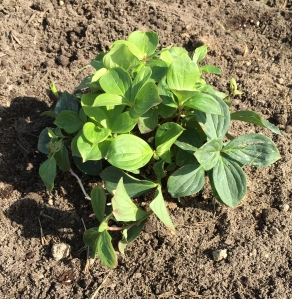
Cornus Canadensis Bunchberry Berries can be eaten raw or added to puddings, preserves and sauces. The fruits are rich in pectin which is a capillary tonic, anti-inflammatory, antispasmodic and hypotensive. Pectin also inhibits carcinogenesis and protects against radiation. Leaves and stems are medicinal, treating aches and pains, kidney and lung ailments, coughs, and fevers. The roots have been used as a cold remedy, and the bark has been used as a laxative. Easily grown in average, medium moisture, well-drained soils in part shade. Avoid dry soils. Winter hardy to USDA Zones 2-6.

Fragaria Chiloensis Coastal Strawberry Produce prolific runners with closely spaced plants that have extensive root systems and are important contributors to sand dune binding. Stl’atl’imx girls used to wear headbands and belts of strawberry runners plaited together in three or four strands (Turner, 1998). Berries were eaten, but not dried (too juicy). The Saanich and Mainland Comox made tea from the leaves. Quileute chewed leaves & applied as a poultice to burns. Skokomish used the whole plant in a tea for diarrhea. Haida used as ingredient for female tonic. Prefers sandy soils but can tolerate other types, full sun to semi-shade, drought tolerant.
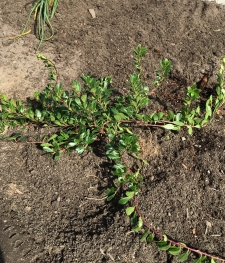
Gaulteria Shallon Salal The berries of Salal were used in many places on the Northwest Coast. Salal was considered one of the most important and plentiful for indigenous peoples. They were used fresh or dried into cakes for winter and celebrations. Salal berries used to be traded and sold to First Nations in the interior British Columbia. The leafy branches of the shrub were used in pit cooking, and cooked as a flavoring in fish soup. It prefers to be grown in partial shade and planted in a rich, well draining, acidic soil. Water regularly and thoroughly during the dry months.

Lonicera Involucrata Black Twinberry Indigenous peoples used the leaves, bark and twigs for a variety of medicinal purposes. An infusion of bark was used as a soak for sore feet and legs, as an eyewash, or in the treatment of coughs. Leaves were chewed and applied to itchy skin and various sores. Reports on the fruit vary from poisonous, to mildly toxic, to bitter and unpalatable, to edible and useful as food, depending on the nation, region or publication. Are found growing in low to subalpine elevation, throughout BC. Prefer Moist conditions, clay, sand or loam soil, and partial shade.
Ribes Divaricatum Wild Gooseberry The berries of Coastal Black Gooseberry are traditionally eaten fresh and occasionally cooked, juiced, sauced, or dried into cakes by virtually all Indigenous people that inhabit the plants range. The inner bark was chewed and swallowed to treat a sore throat and cold. The bark or roots were boiled and used as an eyewash, or for sore throats. The Nisqually used the spines for tattooing using charcoal for colouring. It is sweet and juicy, though a bit on the acid side, with a “very acceptable flavor.” Found in open woods, prairies and moist hillsides, zones 4-8. It can grow in semi-shade (light woodland) or no shade. It prefers moist soil.
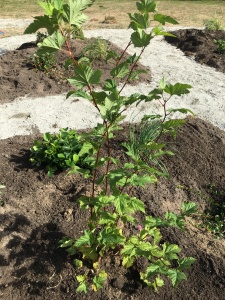
Physocarpus Capitatus Pacific Ninebark A member of the Rose family, Pacific Ninebark grows mostly at low elevations — in open forests, along creeks, and in damp shrubby places. The wood of Pacific Ninebark has been used to make small items such as children’s bows and knitting needles. Some say there are nine layers of bark, leading to its name. A tea made from the bark has been used as a laxative or to induce vomiting, but due to toxicity concerns, caution is advised for any internal use. Prefers moist conditions and is found in coastal and cedar/hemlock ecosystems’s. Tolerant of sun or shade, so-so soil, and wet to dry sites.
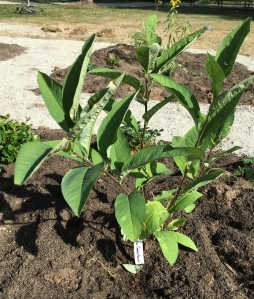
Osmaronia Cerasiformis Indian Plum Indian Plums were eaten in small quantities fresh, cooked, or dried by First Nations people. Flavour of unripe fruit is bitter and astringent, but they become more palatable when they are fully ripe. Leaves, seeds and even fruit may contain small quantities of hydrogen cyanide, and should therefore only be consumed in small quantities. A decoction of the bark of Indian Plum was used to treat tuberculosis. The Saanich made a bark tea as a purgative and tonic. Indian Plum has a analgesic quality to it and the Kwakiutl created a poultice by chewing, and burning the plant and oil and then applying to sore places. The bark was stripped to make harpoon hooks and other utility items. Amenable to conditions both moist and dry, once established it only occasionally needs supplemental water, and is reputedly pest and disease free.













